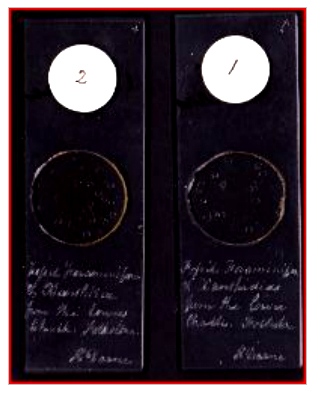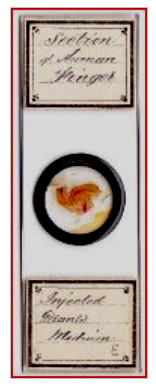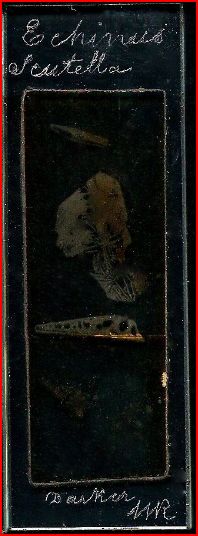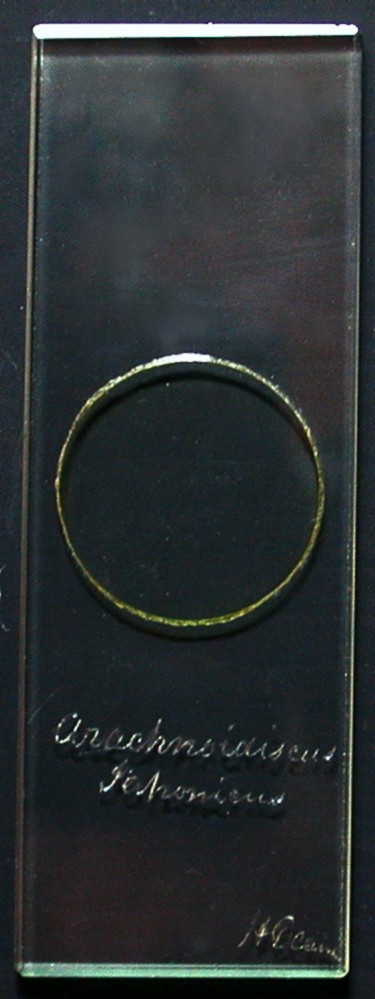
Some historic mounts by Henry Deane (1807-1874)
Peter B. Paisley, Sydney, Australia
Occasionally, miscellaneous lots contain only a single desired slide
such as (say) a Topping or Barnett – but the accompanying
“dross” may contain treasures unsuspected at first sight.
A consignment acquired via the internet included some slides
encrusted with the dirt of many decades. Careful cleaning revealed
nicely bevelled glass, and diamond inscriptions. Soon, the signature
“H. Deane” could be seen. Could it be the Deane
eponymously associated with glycerine jelly? Investigating, I
“struck oil” almost at once.
Two slides were of splendid forensic value: they were of fossil foraminifera – xanthidiae (so called) from the lower chalk at Folkestone. In 1845, Henry Deane succeeded in mounting them from samples of Folkestone chalk treated with hydrochloric acid, exciting the interest of the celebrated fossil-hunter Gideon Mantell: the two subsequently collaborated in communication to the Royal Society. Deane’s work was significant, influencing a seminal phase of English palaeontology. Several diatom species bear his name in their nomenclature, furthermore he coined the generic term Arachnodiscus, in a paper (unpublished) read to the Microscopical Society in March 1847. His contributions to pharmaceutical research made their way into standard British textbooks of therapeutics. The slides are of the smaller “standard” dimensions recommended by the Microscopical Society of London in 1839, bear glass cover slips, and use glycerine jelly mountant. Deane became President of the Pharmaceutical Society of England, and evidently made his own slides, taking pride in their presentation: hence his more expensive unpapered bevelled glass, something forsaken by most mounters following the fashion for papering, which covered up less expensive unfinished glass. Remarkably, at this distance in time, ink inscriptions on the back of the slides have survived, reading “Dr. Lee”. This may refer to Deane’s contemporary the geologist J.E. Lee. Alternatively, the slides may have found their way into the collection of Arthur Bolles Lee, the well known writer on microscopical preparation: the two slides below certainly ended up in a collection of some sort, as evidenced by their numbered labels.

Eponymous renown
The Pharmaceutical Journal (vol.10, 1869, p.20), shows that the
British society held Deane in the highest esteem as a microscopist. First in their list of noted chemist/microscopists, he is given the
accolade cui nomen apud nos semper est in honorem, celebrating
his work in microscopy, and on the Folkestone chalk xanthidiae in
particular. Probably his renown also rested on development of
glycerine mounting media, for which he devised various formulations
(including one with the addition of honey). Today, one seldom finds
published papers specifying “Deane’s medium”,
rather than just “glycerine jelly”. The eponymous term
was sometimes used on slide labels, until at least around 1900,
exemplified below on a late slide by Hume. (Hume, a pharmacist,
evidently wished to acknowledge his illustrious predecessor.)

While it is rare to find it specified on slide labels, the term
“Deane’s medium” occurs scattered through published
work of the middle nineteenth century. The term was presumably
inferred by most English microscopists to indicate that Deane first
used this mounting medium: some historians however give the prior
credit to Wenham. Deane probably deserved his eponymous repute,
since he did more than others in developing successful formulations
using glycerine for mounting, and established it as a standard medium
for slide makers. In any case, he deserves fame for his work on
fossils, regardless of mounting media, as well as his other
contributions to chemistry and pharmacy. His work on the xanthidiae
changed previous views on their status, causing Mantell to change
their nomenclature. His son – also Henry Deane –
emigrated to New South Wales, and carried on the family tradition,
becoming even more publicly prominent in Australia than his father in
England. He was an engineer who inter alia created the Sydney
tramway system, but also made major contributions to palaeobotany,
and became president of the Linnean Society of NSW.
Deane and Darker
Deane and the mounter William Darker must have known each other: both
collaborated with Mantell, who like Deane lived in Clapham. Both were
members of the Microscopical Society of London (later the Royal
Microscopical Society), and both worked with rock and fossil
material, although – on the strength of the slides shown in
this article – they used very different methodological
approaches. They lived within easy distance of each other in London,
suggesting they may have collaborated on slide preparation, or at
least compared mounted material. Darker was at Paradise St., towards
the western edge of Lambeth, and Deane was at The Pavements, on the
eastern edge of Clapham Common (now, indeed, that address is
officially within Lambeth). It would have been an easy cab journey,
or a twenty minute walk. Hopefully, this article may facilitate
identification by researchers of more Deane slides, and add to the
growing evidence on Darker (hitherto obscure, but now well
illustrated by Howard Lynk at www.victorianmicroscopeslides.com
). By 1841, Darker had mounted limestone full of microscopical shell
material, and Deane’s different method in 1845 using
hydrochloric acid enabled much fuller interpretation of soft tissue
remains within some of those fossils.


Slides by Darker and Deane. Darker, an expert lapidarist, used uncovered ground specimens for his rock mounts.
Envoi
It is probably too much to hope that my xanthidiae slides are
the first such made by Deane (although they just might be). They
are certainly early: and these days, to find slides associated with
important original scientific work by “big names” is
rare. So the moral of this brief story, perhaps, is that seller’s
trash may contain collectors’ treasures.
Comments to the author will be welcomed.
Acknowledgements
Thanks to Howard Lynk for images of the Darker slide and the Deane Arachnodiscus slide.
Sources
www.ancestry.com
www.victorianmicroscopeslides.com
Deane, H: On the occurrence of xanthidia and polythalamia in chalk.
Trans. Microscop. Soc. London (1849) 2, 77-79
William A.S. Sarjeant: Gideon Mantell and the “xanthidia”:
Arch. Nat. Hist. (1992) 19(1) 91-100
Microscopy UK Front
Page
Micscape
Magazine
Article
Library
Published in the March 2011 edition of Micscape Magazine.
Please report any Web problems or offer general comments to the Micscape Editor .
Micscape is the on-line monthly magazine of the Microscopy UK website at Microscopy-UK .
© Onview.net Ltd, Microscopy-UK, and all contributors 1995 onwards. All rights reserved. Main site is at www.microscopy-uk.org.uk .